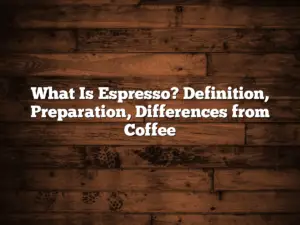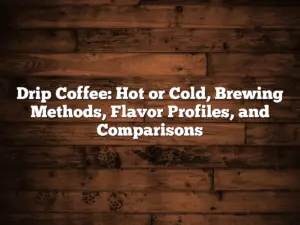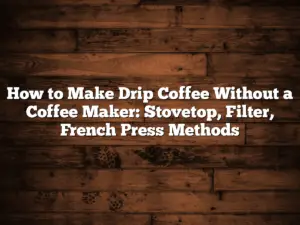Coffee lovers, unite! Let’s dive into the age-old debate that’s been brewing for decades: what is the difference between a coffee maker and a percolator? If you’ve ever found yourself puzzled by these two popular coffee brewing methods, you’re not alone . I’ve been on both sides of this caffeinated conundrum, and I’m here to spill the beans on everything you need to know.
The primary difference between a coffee maker and a percolator lies in their brewing processes and resulting flavors—drip coffee makers offer a cleaner, less bitter taste, while percolators produce a stronger, more robust cup with potential bitterness.
Dive into our detailed comparison to uncover which method suits your taste preferences and lifestyle best . We’ll explore how each brewing technique affects flavor, convenience, and maintenance, helping you make an informed decision on whether a coffee maker or percolator aligns with your coffee needs . Ready to brew up some clarity? Keep reading to discover the full picture and find the perfect coffee solution for you .
Key Facts:
1. Drip coffee makers use gravity to pass water through grounds once, while percolators cycle water multiple times.
2. Percolators typically produce stronger, more bitter coffee than drip makers.
3. Drip coffee makers are generally easier to use and clean than percolators.
4. Percolators were popular in the 20th century but declined with the rise of drip makers in the 1970s.
5. Both methods can brew multiple cups at once, making them suitable for serving groups.
The Brewing Battle: Coffee Maker vs. Percolator
Let’s start by breaking down these two coffee-making contenders . As someone who’s experimented with both methods (and had my fair share of caffeine-fueled mishaps), I can tell you that understanding the ins and outs of each can make a world of difference in your morning brew .
Understanding Coffee Makers

Drip Coffee Maker vs Percolator Infographic – source
When we talk about coffee makers, we’re usually referring to the ubiquitous drip coffee maker . These nifty machines have become a staple in homes and offices worldwide, and for good reason . Here’s the lowdown on how they work:
- Water Reservoir: You fill this with cold water .
- Heating Element: The machine heats the water to near-boiling .
- Shower Head: Hot water drips over ground coffee in a filter basket .
- Filter: Usually paper, it holds the grounds and allows brewed coffee to pass through .
- Carafe: The finished coffee collects here, often kept warm by a hot plate .
The whole process is pretty straightforward, which is why drip coffee makers are so popular . They’re the “set it and forget it” of the coffee world .
The Flavor Profile
Now, let’s talk taste . Drip coffee makers typically produce a cleaner, less bitter brew . Why? Because the water only passes through the grounds once, there’s less chance of over-extraction . This means you’re less likely to end up with a cup that makes your face pucker like you’ve just bitten into a lemon .
Percolator: The Old School Brew Master

How a Percolator Works – source
Now, let’s shift gears to the percolator . This old-school brewing method might remind you of camping trips or your grandparents’ kitchen . But don’t let its vintage vibe fool you – percolators can pack a serious punch .
Here’s how these bad boys work:
- Bottom Chamber: You fill this with cold water .
- Central Tube: As the water heats, it rises through this tube .
- Basket: At the top, hot water sprays over coffee grounds in a perforated basket .
- Recycling Process: The brewed coffee drips back down, and the cycle repeats .
The key difference? In a percolator, the water keeps cycling through the grounds until you decide it’s done (or until your coffee is strong enough to stand a spoon in it) .
The Flavor Profile
Percolator coffee is known for being strong and robust . Some coffee enthusiasts (myself included) might even say it’s a bit… intense . The repeated cycling can lead to over-extraction, resulting in a brew that’s more bitter than a jilted lover .
The Great Taste-Off: Flavor Comparison
Now that we’ve got the basics down, let’s dive into the nitty-gritty of flavor . After all, isn’t that what it’s all about?
Drip Coffee Maker: The Smooth Operator
Drip coffee makers are like that reliable friend who’s always there for you . They produce a balanced, medium-bodied brew that’s pleasing to most palates . The paper filters used in most drip makers trap oils and fine particles, resulting in a cleaner cup with less sediment .
Taste Profile:
– Acidity: Medium
– Body: Light to Medium
– Bitterness: Low to Medium
– Complexity: Moderate
I find that drip coffee is perfect for those mornings when I want to savor my cup without being overwhelmed . It’s also great for showcasing the nuanced flavors of single-origin beans .
Percolator: The Bold Adventurer
Percolator coffee, on the other hand, is like that friend who always convinces you to try something new and slightly terrifying . The repeated cycling of water through the grounds results in a strong, full-bodied brew that’s not for the faint of heart .
Taste Profile:
– Acidity: Low
– Body: Full
– Bitterness: High
– Complexity: Low to Moderate
Personally, I find percolator coffee to be perfect for those mornings when I need an extra kick . It’s also great for adding milk or cream, as the strong flavor can stand up to additions without getting lost .
The Convenience Factor: Ease of Use and Maintenance
Let’s face it – we’re not all morning people . Sometimes, the thought of a complex coffee-making process before caffeine is just too much to bear . So, how do these two methods stack up in terms of convenience?
Drip Coffee Maker: The Low-Maintenance Friend
Drip coffee makers are the epitome of set-it-and-forget-it convenience . Here’s why they’re so user-friendly:
- Simple Setup: Add water, insert filter, add grounds, press button . Done .
- Automatic Shut-Off: Many models turn off automatically, so you don’t have to worry about leaving it on .
- Easy Cleaning: Most parts are dishwasher safe, and regular cleaning is straightforward .
- Consistent Results: Once you find your preferred water-to-coffee ratio, you can expect similar results each time .
I love my drip coffee maker for those mornings when I’m barely functioning . It’s like having a personal barista who doesn’t judge my bed head .
Percolator: The High-Maintenance Hottie
Percolators require a bit more attention and finesse . Here’s what you’re in for:
- Manual Operation: You need to watch and listen to know when the coffee’s ready .
- Timing is Key: Over-percolating can lead to bitter, over-extracted coffee .
- More Involved Cleaning: The multiple parts require thorough cleaning to prevent oil buildup .
- Variable Results: It can take some practice to consistently achieve your preferred strength .
I’ll admit, using a percolator makes me feel like a mad coffee scientist . It’s fun when I have the time, but not ideal for rushed mornings .
The History Lesson: Evolution of Brewing Methods
Now, let’s take a quick trip down memory lane . Understanding the history of these brewing methods can give us some insight into their enduring appeal .
The Rise and Fall of the Percolator
Percolators have been around since the 1800s, with the first patent granted to James Mason in 1865 . They quickly became a popular way to brew coffee, dominating kitchens and campsites for much of the 20th century .
Fun Fact: The percolator’s popularity peaked in the 1970s, with over 80% of American households owning one .
However, the percolator’s reign was about to end . Enter the drip coffee maker .
The Drip Coffee Revolution
In 1972, Mr . Coffee introduced the first automatic drip coffee maker for home use . It was a game-changer, offering a more convenient and consistent brewing method . The result? A rapid decline in percolator popularity .
Why the Shift?
1. Ease of Use: Drip makers were simpler to operate .
2. Consistent Results: Less chance of over-extraction and bitter coffee .
3. Convenience: Automatic shut-off and keep-warm features were appealing .
Today, drip coffee makers dominate the market, but percolators still have their dedicated fans .
Making the Choice: Which One is Right for You?
Alright, we’ve covered a lot of ground . But the big question remains: which one should you choose? Let’s break it down based on different factors .
Taste Preferences
- Choose a Drip Coffee Maker if:
- You prefer a cleaner, less bitter taste
- You enjoy exploring subtle flavors in different coffee beans
- You like your coffee smooth and easy-drinking
- Choose a Percolator if:
- You like your coffee strong and robust
- You enjoy a full-bodied brew
- You don’t mind (or even prefer) a bit of bitterness
Lifestyle Considerations
- Choose a Drip Coffee Maker if:
- You value convenience and quick preparation
- You want a consistent cup every time
- You often make coffee for a group
- Choose a Percolator if:
- You enjoy a more hands-on brewing process
- You like to control the strength of your coffee
- You want a portable option for camping or travel
Budget Factors
- Choose a Drip Coffee Maker if:
- You’re willing to invest in a long-term appliance
- You want features like programmable brewing or built-in grinders
- Choose a Percolator if:
- You’re looking for a more budget-friendly option
- You prefer a simple device with fewer parts that could break
Alternative Brewing Methods: Beyond the Basics
While we’ve been focusing on drip coffee makers and percolators, it’s worth mentioning that these aren’t the only games in town . If you’re feeling adventurous, you might want to explore some other brewing methods:
- French Press: Produces a full-bodied, rich brew .
- Pour-Over: Offers precise control over brewing variables .
- AeroPress: A quick, portable method for a strong, espresso-like coffee .
- Espresso Machine: For those who love concentrated shots of coffee .
- Cold Brew: Perfect for smooth, less acidic iced coffee .
Each of these methods has its own unique characteristics and can be a fun way to expand your coffee horizons .
Maintenance Matters: Keeping Your Brew Clean
No matter which brewing method you choose, proper maintenance is key to consistently great coffee . Let’s look at some cleaning tips for both drip coffee makers and percolators .
Cleaning Your Drip Coffee Maker
- Daily Rinse: Wash removable parts (carafe, filter basket) with warm, soapy water .
- Monthly Deep Clean: Run a cycle with equal parts water and white vinegar to remove mineral buildup .
- Regular Descaling: Use a commercial descaling solution every 3-6 months, depending on water hardness .
For more detailed instructions, check out our guides on how to clean a Cuisinart coffee maker or how to clean a Mr . Coffee coffee maker .
Cleaning Your Percolator
- After Each Use: Disassemble and wash all parts with warm, soapy water .
- Deep Clean: For stubborn stains, use a mixture of water and baking soda .
- Vinegar Rinse: Occasionally run a cycle with diluted vinegar to remove mineral deposits .
Remember, a clean coffee maker not only ensures better-tasting coffee but also extends the life of your equipment .
The Environmental Impact: A Green Perspective
In our caffeine-fueled quest for the perfect cup, it’s easy to overlook the environmental impact of our brewing methods . Let’s take a moment to consider the eco-friendliness of drip coffee makers and percolators .
Drip Coffee Makers: The Paper Problem
Pros:
– Many newer models are energy-efficient with auto-shut-off features .
– Some drip makers use reusable filters, reducing waste .
Cons:
– Paper filters create ongoing waste .
– Plastic components in many models are not biodegradable .
Percolators: The Durable Option
Pros:
– Often made of durable materials like stainless steel .
– No need for disposable filters .
– Can last for decades with proper care .
Cons:
– May use more energy if left on the stove for extended periods .
The Final Verdict: It’s All About Personal Preference
After all this discussion, you mightbe wondering if there’s a clear winner in the coffee maker vs . percolator showdown . The truth is, like many things in life, it comes down to personal preference .
I’ve had mornings where nothing beats the convenience of my trusty drip coffee maker . It’s like a reliable friend who’s always there for you, no matter how bleary-eyed and zombie-like you might be . On the other hand, there are lazy weekends when I enjoy the ritual of using my percolator, listening to the gentle bubbling and anticipating that strong, bold brew .
Here’s my take on when to choose each:
Go for a Drip Coffee Maker if:
– You value consistency and convenience above all else
– You prefer a cleaner, less bitter taste
– You often make coffee for a group
– You’re not a morning person and need your coffee ASAP
Opt for a Percolator if:
– You enjoy a stronger, more robust cup of joe
– You like having control over the brewing process
– You want a portable option for camping or travel
– You appreciate the nostalgia and ritual of traditional brewing methods
Remember, there’s no rule saying you can’t have both! Many coffee enthusiasts (myself included) enjoy having options depending on their mood or the occasion .
FAQs About what is the difference between a coffee maker and a percolator:
Q: What is the main difference between a coffee maker and a percolator?
A: The main difference lies in the brewing process . A drip coffee maker passes hot water through coffee grounds once, while a percolator cycles the water through the grounds multiple times, resulting in a stronger brew .
Q: Which method produces stronger coffee?
A: Generally, percolators produce stronger coffee due to the repeated cycling of water through the grounds . However, the strength can be adjusted in both methods by varying the amount of coffee used .
Q: How do I choose between a coffee maker and a percolator?
A: Consider your taste preferences, convenience needs, and brewing capacity . If you prefer a cleaner taste and convenience, go for a drip coffee maker . If you like strong coffee and don’t mind a more hands-on process, a percolator might be for you .
Q: Can a coffee maker be used for brewing espresso?
A: Standard drip coffee makers cannot brew true espresso, which requires high pressure . However, some coffee makers come with built-in espresso makers . For a quick alternative, you might want to learn how to use an AeroPress for espresso-like coffee .
Q: How often should I clean my coffee maker or percolator?
A: For optimal taste and hygiene, you should rinse your coffee maker or percolator after each use and perform a deep clean monthly . For specific instructions, check out our guide on how to clean a coffee maker with vinegar .
Summary:
In this deep dive into the difference between a coffee maker and a percolator, we’ve explored the unique brewing processes, flavor profiles, convenience factors, and historical context of these two popular coffee-making methods . The main takeaway is that drip coffee makers offer convenience and a cleaner taste, while percolators provide a stronger, more robust brew with a hands-on approach .
Ultimately, the choice between a coffee maker and a percolator comes down to personal preference, lifestyle, and taste . Whether you’re a fan of smooth, easy-drinking coffee or prefer a bold, in-your-face brew, there’s a method that’s perfect for you .
So, coffee lovers, I challenge you to step out of your comfort zone . If you’ve been a die-hard drip coffee fan, why not give a percolator a try? Or if you’ve been percolating for years, maybe it’s time to experience the consistency of a drip maker . After all, the world of coffee is vast and exciting – why limit yourself to just one brewing method?




